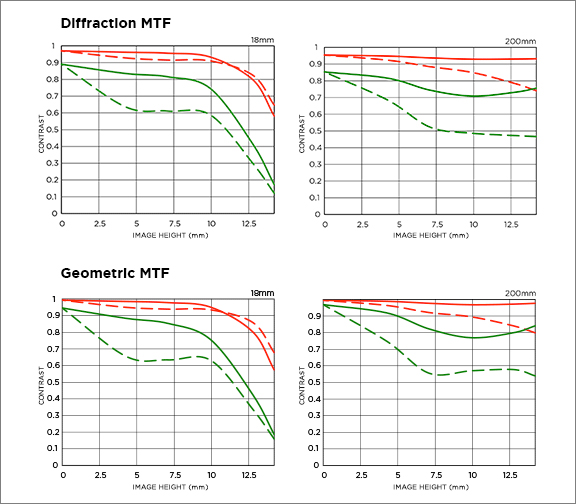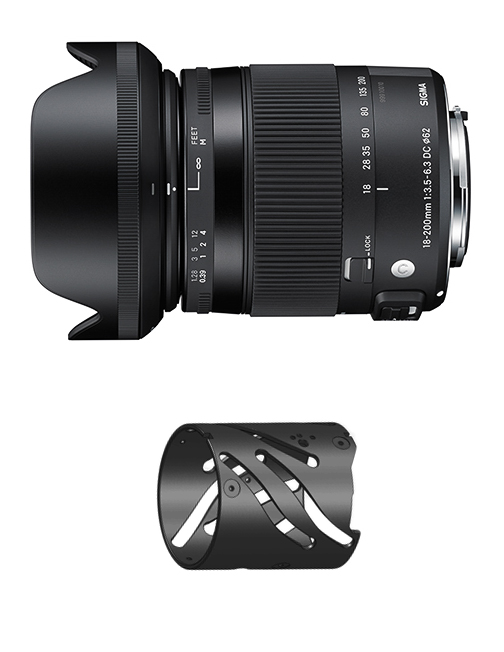Our technical product information has been expanded to now include both Geometric and Diffraction MTF charts for new Sigma lenses. You can take a look at the technical information about the new Sigma 18-200mm F3.5-6.3 DC OS HSM | Contemporary lens on the Sigma Global Vision website to see these graphs plotted as part of the total package of information we share to help photographers understand the performance of our lenses.

Previously, only the Diffraction MTF charts have been published, and we will be adding in the Geometric MTF charts in the near future to our full line of lenses. Why, you may ask, are we doing this? Simply, because it helps provide a clearer picture of both theoretical and practical lens performance. And this information allows photographers to more fully understand and comprehend the real-world impact on their imagery of the MTF data.
As you can see, these two charts for the 18-200mm are similar, but not identical. This is due to the consideration of the diffraction of light as it passed through the elements of a lens in the Diffraction calculations. The Geometric chart is a simplified approach that does not include the effects of diffraction on the results.

Both charts have their purposes and applications. The Geometric chart shows the theoretical best performance of a lens, based on assuming light as a particle. From a computational standpoint, this is a much easier data set to crunch. However, outside of the laboratory, in real-world photography situations, light behaves as light truly behaves as it passes through the lens elements, and this is where the Diffraction MTF chart comes into play. So the Diffraction MTF regards light as a wave. Diffraction exists at all apertures, and as light passes through lenses, the light waves do exhibit the effects of diffraction. So, by illustrating and graphing both the lab-exclusive (Geometric) and real-world results (Diffraction) charts, it gives photographers a much clearer picture of overall lens performance.

Imagine for a moment, that the Geometric MTF chart is explained as the operations of the classic video game “PONG” and that the graphical ball is approaching the graphical wall at a forty five degree angle. Upon impact, The “ball” takes a perfect straight-line trajectory after bouncing off the stationary paddle and its course to the far court is not impacted at all by any other factors.

Now, imagine the Diffraction MTF chart is a birds-eye view of an outdoor tennis practice wall, and that it has just rained a bit. A serving machine fires a tennis ball at the same forty five degree angle to the wall with equivalent scaled velocity. Even with the same angle of incidence and reflection and overall similar trajectory from your vantage point, there are a lot more forces at play. While the ball itself may chart a very similar path, there is a bit of fuzz and water vapor that explodes off the ball on contact, and there is the coefficient of drag, plus gravity that all factor into the actual path of that tennis ball. It’s a much more complex model to calculate.
Diffraction is a factor any time light passes through a lens. There is no such thing as perfect transmission. Some slight percentage of the light is scattered and lost, even in the most well-designed lenses. (And a point of light will be rendered not as a point, but as a circle as it passes through a lens, but that’s a story for another day.) That is how optical physics operate in the world. Lens designers craft lenses to create the best possible results within the design parameters for that particular lens. For example, there are different budgetary and form factor issues to contend with for a compact high-ratio variable aperture zoom lens incorporating Optical Stabilization and a world-beating fast-aperture wide angle prime lens.
But in each case, the Sigma lens designers are going to work to craft a lens that offers the best possible performance for that type of lens. This include the grouping and configuration of the lens elements, the location of the focusing and zooming elements, OS element position, if included, and the careful selection of glass type for each and every element in the optical path.


The intention, always, is on optimizing performance. A given lens may have several FLD elements, while another may include some SLD or ELD elements, and aspheric elements. What truly matters most is how all the lens elements act as a group to best focus the various wavelengths of light on the camera sensor. And this is what the Diffraction MTF chart illustrates: a closer representation to the way the light you will capture through your camera. For example, this is how the lens will behave when you’re making portraits, and there’s fine details and catchlight in the flowing hair—because almost all photographers make photos out in the real world, not inside specialized testing facilities! Sigma also includes distortion and vignetting data for lenses, again to give a clearer picture of practical lens performance.
Sigma has created its own state of the art MTF Testing protocols, using the A1 device inside our one and only factory in Aizu, Japan. At the heart of this device is the super-resolution Merrill Generation Foveon Sensor. And each and every lens in the Art, Sports, and Contemporary lines are individually tested for optical performance before leaving the factory. This means that every single lens that lands in the hands of a photographer will operate to the level of performance illustrated in the Diffraction MTF charts.
Sigma is serious about rethinking lenses. From the exclusive Mount Conversion Service, and the exclusive USB dock for microfocus adjustments and firmware updates, to crafting exceptional lenses, the Sigma Global Vision is constantly empowering photographers with incredible tools to realize their creative vision. Sharing both the Geometric and Diffraction MTF charts for Sigma lenses gives photographers a clearer picture of overall lens performance.

this looks great
I have 50-500MM, I want to fix 2X. It will get clear photos